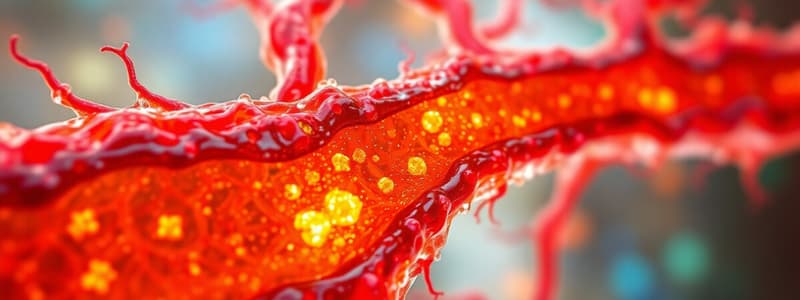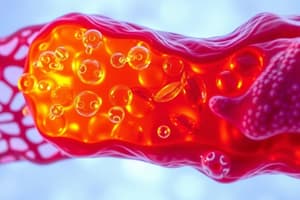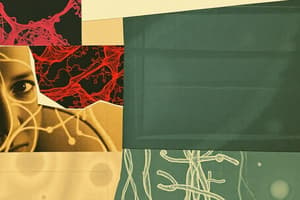Podcast
Questions and Answers
Which of the following cell types is MOST associated with the initial formation of granulation tissue during tissue repair?
Which of the following cell types is MOST associated with the initial formation of granulation tissue during tissue repair?
- Neutrophils
- Myofibroblasts
- Fibroblasts (correct)
- Epithelial cells
In the context of tissue repair, what is the primary role of collagen type III?
In the context of tissue repair, what is the primary role of collagen type III?
- Forms the initial scaffolding of granulation tissue (correct)
- Inhibits fibroblast proliferation to prevent excessive scarring
- Facilitates angiogenesis by providing structural support to new blood vessels
- Provides high tensile strength in mature scar tissue
What is the correct sequence of events in tissue repair?
What is the correct sequence of events in tissue repair?
- Regeneration, Inflammation, Remodeling
- Inflammation, Regeneration, Remodeling (correct)
- Inflammation, Remodeling, Regeneration
- Remodeling, Inflammation, Regeneration
Following a skin injury, such as a paper cut, approximately how long does is take for the remodeling phase of tissue repair to begin?
Following a skin injury, such as a paper cut, approximately how long does is take for the remodeling phase of tissue repair to begin?
Platelet-derived growth factor (PDGF) and fibroblast growth factor (FGF) are secreted by macrophages and promote which of the following processes during tissue repair?
Platelet-derived growth factor (PDGF) and fibroblast growth factor (FGF) are secreted by macrophages and promote which of the following processes during tissue repair?
What is the MAIN function of Tissue Growth Factor beta (TGF-β) in tissue repair?
What is the MAIN function of Tissue Growth Factor beta (TGF-β) in tissue repair?
What is the role of matrix metalloproteinases (MMPs) during tissue repair, and how is this activity modulated by TGF-β?
What is the role of matrix metalloproteinases (MMPs) during tissue repair, and how is this activity modulated by TGF-β?
Which of the following BEST describes the sequence of events during angiogenesis in tissue repair?
Which of the following BEST describes the sequence of events during angiogenesis in tissue repair?
Following a superficial skin injury that heals without scarring, which process is MOST responsible for the restoration of normal tissue structure and function?
Following a superficial skin injury that heals without scarring, which process is MOST responsible for the restoration of normal tissue structure and function?
Scar formation is MOST likely to occur when:
Scar formation is MOST likely to occur when:
What distinguishes myofibroblasts from regular fibroblasts?
What distinguishes myofibroblasts from regular fibroblasts?
In the context of tissue repair, what is angiogenesis primarily responsible for?
In the context of tissue repair, what is angiogenesis primarily responsible for?
Which of the following BEST describes the role of inflammatory cells in tissue repair?
Which of the following BEST describes the role of inflammatory cells in tissue repair?
Which event primarily characterizes the regeneration phase of tissue repair?
Which event primarily characterizes the regeneration phase of tissue repair?
If a wound fails to undergo complete regeneration, what is the MOST likely outcome?
If a wound fails to undergo complete regeneration, what is the MOST likely outcome?
What is the significance of the transition from collagen type III to collagen type I during the remodeling phase?
What is the significance of the transition from collagen type III to collagen type I during the remodeling phase?
If a patient has a chronic wound with impaired healing, which of the following growth factors would MOST likely be deficient, contributing to reduced collagen deposition and tissue repair?
If a patient has a chronic wound with impaired healing, which of the following growth factors would MOST likely be deficient, contributing to reduced collagen deposition and tissue repair?
Which aspect of fibroblast function is DIRECTLY inhibited by Tissue Growth Factor beta (TGF-β)?
Which aspect of fibroblast function is DIRECTLY inhibited by Tissue Growth Factor beta (TGF-β)?
How does the role of angiogenesis change as tissue repair progresses from the early to later stages?
How does the role of angiogenesis change as tissue repair progresses from the early to later stages?
A patient with a skin laceration that extends into the dermis heals with significant scar tissue. Why did the tissue heal via scar formation rather than regeneration?
A patient with a skin laceration that extends into the dermis heals with significant scar tissue. Why did the tissue heal via scar formation rather than regeneration?
Flashcards
Repair, Healing, Resolution
Repair, Healing, Resolution
Interchangeable terms referring to the body's process of mending damaged tissues.
Regeneration
Regeneration
Occurs in tissues with high cell division capacity, like skin, intestines, and liver, restoring original structure and function.
Connective Tissue Components
Connective Tissue Components
Blood vessels contribute to angiogenesis. Fibroblasts produce extracellular matrix proteins. Collagen and elastin are structural proteins.
Myofibroblasts
Myofibroblasts
Signup and view all the flashcards
Collagen Type I
Collagen Type I
Signup and view all the flashcards
Collagen Type III
Collagen Type III
Signup and view all the flashcards
Tissue Injury Phase
Tissue Injury Phase
Signup and view all the flashcards
Regeneration Phase
Regeneration Phase
Signup and view all the flashcards
Remodeling Phase
Remodeling Phase
Signup and view all the flashcards
One Day, One Week, One Month
One Day, One Week, One Month
Signup and view all the flashcards
Tissue Repair
Tissue Repair
Signup and view all the flashcards
Orchestrators of Proliferation
Orchestrators of Proliferation
Signup and view all the flashcards
Key Players in Tissue Repair
Key Players in Tissue Repair
Signup and view all the flashcards
Platelet-Derived Growth Factor and Fibroblast Growth Factor (PDGF & FGF)
Platelet-Derived Growth Factor and Fibroblast Growth Factor (PDGF & FGF)
Signup and view all the flashcards
Tissue Growth Factor Beta (TGF-β)
Tissue Growth Factor Beta (TGF-β)
Signup and view all the flashcards
Metalloproteinases
Metalloproteinases
Signup and view all the flashcards
Fibroblast growth factor
Fibroblast growth factor
Signup and view all the flashcards
Inflammation in Tissue Repair
Inflammation in Tissue Repair
Signup and view all the flashcards
Remodeling in Tissue Repair
Remodeling in Tissue Repair
Signup and view all the flashcards
Scar Formation
Scar Formation
Signup and view all the flashcards
Study Notes
- Repair, healing, and resolution are interchangeable terms.
- Regeneration occurs in cells with high proliferative capacity, like skin, intestines, and liver.
Connective Tissue Components
- Blood vessels contribute to angiogenesis
- Fibroblasts produce extracellular matrix proteins like collagen
- Fibroblasts produce structural proteins and ground substance such as collagen, elastin, and proteoglycans.
- Myofibroblasts are specialized fibroblasts with contractile properties.
- Collagen type one has high tensile strength.
- Collagen type three is in reticular connective tissue and granulation tissue.
Tissue Regeneration and Repair: Three Phases
- Tissue Injury: Coagulation factors and platelets fill defect; inflammatory cells recruited to fight infection.
- Regeneration Phase: Stem cell proliferation and differentiation occur. Granulation tissue forms as a scaffold. Angiogenesis occurs; epithelial cells proliferate to "bridge" the wound.
- Remodeling: New cells fill the void; collagen type three converts to collagen type one.
Timeline of Tissue Regeneration
- One day: Tissue injury and inflammation.
- One week: Regenerative materials accumulate and start to build.
- One month: Remodeled end product with new cells.
Cell Migration and Proliferation
- Fibroblasts migrate and proliferate, depositing extracellular matrix proteins like collagen.
- Growth factors and cytokines, secreted by macrophages, orchestrate proliferative properties.
- Macrophages and fibroblasts are key players in this process.
- Platelet-derived growth factor and fibroblast growth factor promote collagen fibroblast proliferation and tissue growth.
- Tissue growth factor beta (TGF-β) contributes to fibrosis and scarring by stimulating fibroblast migration and proliferation, increasing collagen and fibronectin synthesis, and inhibiting metalloproteinases.
- Metalloproteinases break down the extracellular matrix
Angiogenesis
- Fibroblast growth factor recruits peri-endothelial cells and smooth muscle cells.
- Endothelial proliferation is suppressed towards the end of vessel formation.
- Basal lamina is deposited to complete blood vessel development.
Sequence Recap
- Inflammation, regeneration and remodeling, and tissue repair are the sequence of events.
Tissue Repair Outcomes
- One day: Inflammation and blood clot formation.
- Up to seven days: Accumulation of materials, macrophages, secretions, and start of angiogenesis.
- Remodeling involves laying down granulation tissue and increased fibroblastic proliferation, producing collagen type three.
- Collagen type three replaced with collagen type one over time.
- Epithelial regeneration may occur, especially in skin.
- By one month, tissue either regenerates or forms a scar.
- Regeneration restores tissue; lack of regeneration leads to scarring
Scarring
- Increased collagen deposition can lead to fibrosis and scarring if regeneration is not possible.
Studying That Suits You
Use AI to generate personalized quizzes and flashcards to suit your learning preferences.




